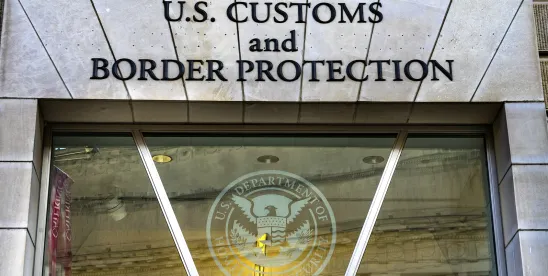US Customs and Border Protection (CBP) issued guidance on its Cargo Systems Messaging Service[1] on April 4, 2025 implementing the first round across-the-board 10% duty under the President’s reciprocal tariff executive order (the Reciprocal Tariffs EO), and issued additional guidance on April 8, 2025 concerning the Reciprocal Tariffs EO’s second round of country-specific tariffs (together, the CBP Guidance). The 10% duty went into effect on April 5 and the country-specific tariffs are effective on April 9, 2025. Both are imposed on most goods imported into the US, with narrow exceptions.
Tariff HTSUS Codes
A Harmonized Tariff Schedule of the United States (HTSUS) code is a unique classification used to identify and categorize goods for import and export purposes. These codes help determine the applicable tariff rates and regulations for specific items entering the US.
10% Worldwide Tariff
The CBP Guidance requires importers to use HTSUS code 9903.01.25 when filing entry summaries for all imported goods subject to the 10% tariff. This applies to goods entered for consumption, or withdrawn from warehouse for consumption, on or after 12:01 a.m. EDT on April 5, 2025, unless they are subject to country-specific tariffs or fall under one of the exceptions listed below.
Country-Specific Tariffs
The CBP Guidance also requires importers to apply the following country-specific HTSUS code listed in Annex I of the Reciprocal Tariffs EO. These country-specific ad valorem duty rates will replace the 10% additional ad valorem duty under HTSUS code 9903.01.25. This applies to goods entered for consumption, or withdrawn from warehouse for consumption, on or after 12:01 a.m. EDT on April 9, 2025, unless they fall under one of the exceptions listed below.
HTSUS codes for select countries are set forth below; the full list is available in Annex I.
- 9903.01.50: Articles the product of Jordan or the European Union (Austria, Belgium, Bulgaria, Croatia, Cyprus, Czechia, Denmark, Estonia, Finland, France, Germany, Greece, Hungary, Ireland, Italy, Latvia, Lithuania, Luxembourg, Malta, Netherlands, Poland, Portugal, Romania, Slovakia, Slovenia, Spain, Sweden) will be assessed an additional ad valorem rate of duty of 20%.
- 9903.01.53: Articles the product of Brunei, Japan, or Malaysia will be assessed an additional ad valorem rate of duty of 24%.
- 9903.01.54: Articles the product of South Korea will be assessed an additional ad valorem rate of duty of 25%.
- 9903.01.55: Articles the product of India will be assessed an additional ad valorem rate of duty of 26%.
- 9903.01.63: Articles the product of China, including Hong Kong and Macau, will be assessed an additional ad valorem rate of duty of 34%.
- 9903.01.72: Articles the product of Vietnam will be assessed an additional ad valorem rate of duty of 46%.
Exceptions
The above tariffs do not apply to goods that fall within one of the following categories. Importers should not use the HTSUS codes listed above and should instead use the alternate HTSUS codes listed below:
- 9903.01.25 – Goods in transit with country-specific rates: Goods from countries with a country-specific duty rate are loaded onto a vessel in transit on or after 12:01 a.m. EDT April 5, 2025, and before 12:01 a.m. EDT April 9, 2025, and entered for consumption or withdrawn from warehouse for consumption before 12:01 a.m. EDT May 27, 2025, are subject to the 10% additional tariff, rather than the country-specific rate.
- 9903.01.26 – USMCA-origin goods from Canada: Goods that originate in Canada, including those entered free of duty under the United States-Mexico-Canada Agreement (USMCA).
- 9903.01.27 – USMCA-origin goods from Mexico: Goods that originate in Mexico, including those entered free of duty under the USMCA.
- 9903.01.28 – Goods in transit: Goods loaded onto a vessel at the port of loading before 12:01 a.m. EDT on April 5, 2025, and entered for consumption or withdrawn from warehouse on or after this date. Notably, CBP clarifies that importers have until 12:01 a.m. EDT on May 27, 2025 to declare these items to use this code.
- 9903.01.29 – Goods from sanctioned countries: Articles from countries subject to US sanctions (e.g., Belarus, Cuba, North Korea, Russia).
- 9903.01.30 – Donations for humanitarian purposes: Donations intended for human suffering relief, such as food, clothing, and medicine.
- 9903.01.31 – Informational materials: Goods considered informational materials, such as books, films, photos, microfilm, and news wire feeds.
- 9903.01.32 – Articles in Annex II: Goods specifically enumerated in Annex II.
- 9903.01.33 – Iron, steel, aluminum, and vehicle parts: Certain articles of iron, steel, aluminum, and passenger vehicles or light trucks, as well as parts subject to Section 232 actions.
- 9903.01.34 – Goods with US content: Articles with at least 20% US-origin content will not be subject to tariffs under the Reciprocal Tariffs EO on the US portion; only the non-US content will be tariffed.
The above tariffs also do not apply to goods that are properly entered under certain provisions of HTSUS Chapter 98, as long as they meet CBP’s regulations. However, there are important exceptions:
- 9802.00.80 – Articles assembled abroad: Additional duties will apply to the value of the assembled article from abroad, minus the cost of any US-made parts.
- 9802.00.40, 9802.00.50, and 9802.00.60 – Repairs, Alterations, or Processing: Additional duties apply to the value of the work done abroad.
Tariff Mitigation Strategies
De Minimis Exemption
As noted in our previous client alert, shortly after releasing the Reciprocal Tariffs EO, the Trump Administration issued another executive order announcing that the $800 de minimis exemption would not be available for goods originating in or shipped from China and Hong Kong. CBP’s guidance confirms that the exemption remains available for shipments from other countries—at least for now. Importers sourcing low-value goods from non-Chinese suppliers may continue to rely on Section 321 entry, though future limitations could be imposed.
Foreign Trade Zones (FTZs)
The guidance reiterates that goods entered into FTZs under privileged foreign (PF) status are subject to the reciprocal tariffs upon withdrawal. This means that even if importers process or assemble goods within the FTZ, they will still be subject to the reciprocal tariffs upon withdrawal for US consumption.
Duty Drawback
In our prior client alert, we noted that the Reciprocal Tariffs EO did not restrict duty drawback—suggesting the possibility of recovery. CBP has now confirmed that duties paid under the reciprocal tariff are eligible for drawback, an important clarification. Duty drawback provides flexible opportunities for relief, including:
- Unused Merchandise Drawback – For goods exported without use in the US.
- Manufacturing Drawback – For imported components used in goods that are exported out of the US.
- Rejected Merchandise Drawback – For defective or nonconforming goods returned or destroyed under CBP supervision.
- Third-Party Drawback Agreements – Importers without sufficient exports may partner with exporters to share drawback benefits.
Critically, across many drawback categories, the exported items need not be identical to the imported goods—as long as they share the same 8-digit HTSUS classification, they may qualify for drawback. This classification-based matching significantly expands eligibility and should be evaluated as part of any mitigation strategy.
Conclusion
The CBP Guidance offers critical clarity on tariff scope and administration while reinforcing the importance of compliance strategies. Importers should take proactive steps to prepare for the new tariffs by reviewing their operations and identifying potential mitigation strategies. This includes auditing HTSUS classifications to ensure accuracy, including the appropriate Chapter 99 codes for exemptions. Importers should also evaluate their supply chains to determine opportunities for sourcing alternatives or utilizing FTZs. Exploring duty drawback options is key, and importers should consider formalizing these programs where appropriate. It is essential to stay informed on any additional guidance, particularly regarding the country-specific tariffs effective on April 9. Early engagement with legal or trade advisors will help minimize exposure and facilitate compliance.
We continue to monitor developments and are available to assist clients in navigating this evolving landscape. For additional information, please contact the International Trade Controls team.
[1] We note that while CBP implemented the February and March tariffs imposed on Canada, Mexico, and China through Federal Register notices, it used the Cargo Systems Messaging Service (CSMS) for its most recent announcement on the reciprocal tariffs (and may follow up with Federal Register notices). The reason for this deviation from the norm is unclear (and may be simply a result of the fast-moving pace of changes to tariff policy), but industry should be aware of the distinction and should monitor CSMS as well as the Federal Register for changes.




 />i
/>i
